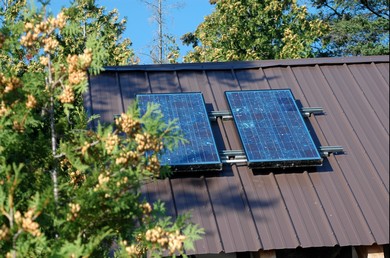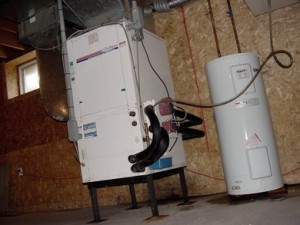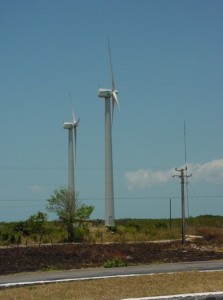If you’re planning to build a new house or cottage, you’ve got decisions to make that go way beyond floor plans, roof designs and wallpaper samples. Sure, visuals like these are important, but there are also a whole lot of other home building design decisions that will go on affecting world climate, our environment and your pocket book for as long as your house stands. A lot of this influence comes down to the element carbon.
The Carbon Factor
 Modern society runs on carbon in the form of fossil fuels, and besides debilitating price increases for gasoline, oil and natural gas, there’s another big problem with our carbon-based lifestyle. It’s warming up the world.
Modern society runs on carbon in the form of fossil fuels, and besides debilitating price increases for gasoline, oil and natural gas, there’s another big problem with our carbon-based lifestyle. It’s warming up the world.
The way you build a new house exerts many times more influence on carbon pollution than how you manage the thermostat or light fixtures or shower use in an older home. That’s because huge energy efficiency gains are possible with the right kind of home design, especially when those design decisions are informed by a 21st century carbon-consciousness. The key is understanding the significance of carbon pollution and designing buildings to minimize it.
Growing stacks of scientific evidence point to the fact that the world’s temperature is rising and that carbon-rich gases added to the atmosphere are partially responsible for this change. This is global warming and one of the most significant gases causing the so-called ‘greenhouse effect’ is ordinary carbon dioxide.
- Every time fossil fuel is burned, it releases carbon compounds into the atmosphere, and much of this is colourless, odourless, non-toxic carbon dioxide.
- Sounds innocent enough, except that so much of today’s carbon dioxide output includes brand new carbon that hasn’t been in the biosphere for millions of years, if it even ever was.
- Current atmospheric concentrations of carbon dioxide have risen well above natural levels, and this condition captures and retains more of the sun’s energy, making the weather more volatile and more violent as average temperatures rise.
- Beating the greenhouse effect comes down to a brand new challenge for all of humanity: We’ve all got to go on a low-carb diet of a new and different sort.
The Benefits of a Carbon-Conscious Home Design:
- Can save you tons of money in energy costs.
- Helps reduce reliance on potentially volatile sources of energy.
- Is good environmental stewardship.
Maximize Heating and Cooling Efficiency
 Not all insulation systems with the same R-value perform the same way.
Not all insulation systems with the same R-value perform the same way.- That’s why you should consider non-hollow wall and roof framing systems such as structural insulated panels (SIPs) and insulated concrete forms (ICFs).
- SIPs offer especially impressive energy performance. One Brock University study showed that a SIPs house used 60% less energy than an identical stud-frame home built to code with the same nominal R-values and tested in side-by-side situations.
Minimize Carbon-to-Energy Ratio
- Wood stoves, pellet stoves and solar collectors are all carbon-neutral sources of heat. The carbon dioxide released by burning biomass fuels was already in the biosphere previously, unlike fossil-based carbon which is all new.
- If you must opt for a fossil fuel heat source, choose a fuel type that offers the most heat for the least carbon burden. Natural gas and propane release 25% less carbon per unit of heat output than oil and 50% less carbon than coal (most commonly used for electrical generation).
Choose 21st-Century Energy Technologies
 On-demand hot water heaters eliminate standby energy loses from tank-style water heaters.
On-demand hot water heaters eliminate standby energy loses from tank-style water heaters.- Radiant in-floor heating provides greater comfort at lower room temperatures.
- Choose appliances with an Energuide label that shows close-to-minimum energy consumption compared with competitive models.
Choose florescent lights with energy-saving electronic ballasts.
- Tailoring your building plans to curb global warming isn’t about sacrifice. It’s really about building smart in a way that offers greater long-term economy, lower foreign energy dependency and building details that anticipate the needs and values of the new century.
It’s Easier Being Green
- A fundamental shift in the environmental status of grid-delivered electricity is unfolding right now, but unless you understand the significance you might miss out on the benefits.
Conventional Electricity
- Until recently, anyone describing conventional electricity as ‘clean’ was either misinformed or deceitful.
- Sure, you’ll never see smog pouring out of a wall outlet, but the industrial activity behind traditional electrical generation comes at a steep environmental price.
- Airborne particulates from coal-fired plants, nuclear waste that still kills 100,000 years from now and mercury-contaminated watersheds from hydroelectric flooding are all part of the hidden pollution behind old-style electrical power.
Green Sources of Electricity
- New, certified-green sources of electricity have come online.
- A growing number of Canadians now have the option of paying modest premiums for environmentally-sound sources of electrical power, opening up a whole new world of low-carbon home design options.
- Now you can honestly consider specific sources of household electricity as green and completely carbon neutral.